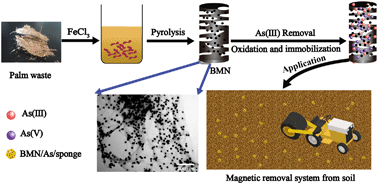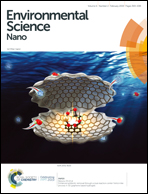Oxidation and removal of As(iii) from soil using novel magnetic nanocomposite derived from biomass waste†
Abstract
A novel biomass-derived magnetic nanocomposite, named BMN, was fabricated via one-step pyrolysis process. BMN exhibited excellent As(III) removal capability, high adsorption capacity (16.23 mg g−1), magnetism, reusability and low cost. Importantly, when BMN was loaded onto sponges with a microporous structure, its removal of As(III) from soil capability was improved. The system of BMN and sponges could efficiently remove As(III) from soil and the resulting BMN/sponge/As(III) complex could be easily separated from soil using a magnet. In addition, when BMN was loaded on filter paper, the system of BMN and filter paper could be conveniently used as an excellent filter layer to control migration of As(III) in soil. Pot incubations indicated that BMN could increase the pH of soil and decrease the concentration of available arsenic in soil. As(III) ion removal by BMN occurred via three pathways: (1) adsorption of As(III) anions via electrostatic attractions, (2) oxidation of As(III) to As(V) by reactive oxygen, and (3) immobilization of As(III) and As(V) by iron nanoparticles. Therefore, this work provides a low-cost method for removal of As(III) from soil, also promoting recovery and utilization of palm waste.



 Please wait while we load your content...
Please wait while we load your content...